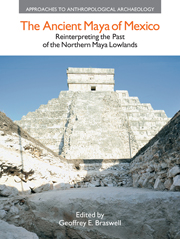Book contents
- Frontmatter
- Dedication
- Contents
- Contributors
- List of Figures
- List of Tables
- 1 The Ancient Maya of Mexico: Reinterpreting the Past of the Northern Maya Lowlands
- Part I THE PRECLASSIC PERIOD
- Part II THE EARLY AND LATE CLASSIC PERIODS
- Part III THE TERMINAL CLASSIC AND EARLY POSTCLASSIC PERIODS
- 8 The Nunnery Quadrangle of Uxmal
- 9 In the Shadow of the Pyramid: Excavations of the Great Platform of Chichen Itza
- 10 Divide and Rule: Interpreting Site Perimeter Walls in the Northern Maya Lowlands and Beyond
- Part IV THE LATE POSTCLASSIC TO HISTORICAL PERIODS
- Part V CONCLUSIONS
- Index
10 - Divide and Rule: Interpreting Site Perimeter Walls in the Northern Maya Lowlands and Beyond
from Part III - THE TERMINAL CLASSIC AND EARLY POSTCLASSIC PERIODS
- Frontmatter
- Dedication
- Contents
- Contributors
- List of Figures
- List of Tables
- 1 The Ancient Maya of Mexico: Reinterpreting the Past of the Northern Maya Lowlands
- Part I THE PRECLASSIC PERIOD
- Part II THE EARLY AND LATE CLASSIC PERIODS
- Part III THE TERMINAL CLASSIC AND EARLY POSTCLASSIC PERIODS
- 8 The Nunnery Quadrangle of Uxmal
- 9 In the Shadow of the Pyramid: Excavations of the Great Platform of Chichen Itza
- 10 Divide and Rule: Interpreting Site Perimeter Walls in the Northern Maya Lowlands and Beyond
- Part IV THE LATE POSTCLASSIC TO HISTORICAL PERIODS
- Part V CONCLUSIONS
- Index
Summary
Abstract
Walls surrounding all or part of a site center have long been recognized as important archaeological features, but often little consideration is given to their function beyond their apparent defensive use. Recent investigations of the site wall at Chichen Itza in the northern lowlands highlight the need for a strong framework within which to interpret wall features, as well as the importance of viewing wall structures as dynamic systems that may have served multiple functions simultaneously or over time. Such a framework will allow researchers to understand site walls as part of larger systems of social control in addition to providing insight into the practice of warfare among the ancient Maya. In the case of Chichen Itza, the wall that surrounds a large part of the ceremonial center appears to have been built originally as a symbolic structure, part of an elite program of separating the ceremonial precinct from its mundane surroundings. In contrast, late additions to the wall indicate the possibility of an increased need for defense in the site center.
In 1976, E. Wyllys Andrews V and Edward Kurjack published one of the earliest reports on walled sites in the Maya area, a discussion of the sites and site walls at Ake, Cuca, and Muna in the northern lowlands (Figure 1.1). In this work, which was based on ground survey and aerial reconnaissance, Andrews and Kurjack recognized the usefulness of site perimeter walls in understanding patterns of political organization, boundary creation, and warfare among the ancient Maya.
- Type
- Chapter
- Information
- The Ancient Maya of MexicoReinterpreting the Past of the Northern Maya Lowlands, pp. 264 - 282Publisher: Acumen PublishingPrint publication year: 2012



